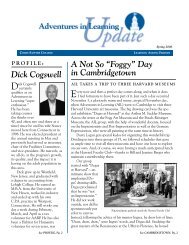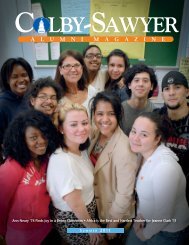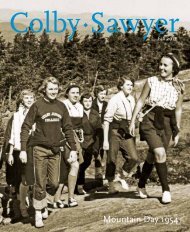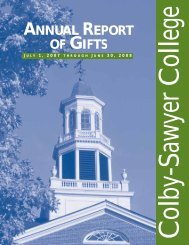A L U M N I M A G A Z I N E - Colby-Sawyer College
A L U M N I M A G A Z I N E - Colby-Sawyer College
A L U M N I M A G A Z I N E - Colby-Sawyer College
Create successful ePaper yourself
Turn your PDF publications into a flip-book with our unique Google optimized e-Paper software.
With members of the Sho family (l to r: German,<br />
Placido, Antonio, the author, Hilario, Geraldo, and<br />
Thomas) after harvesting our lunch, which was the<br />
heart of a cohune palm tree from the jungle outside<br />
their thatched dwelling in Na Luum Ca, Belize.<br />
a locale more perfectly named, for this family—Antonio and<br />
Eugenia Sho and their ten children (some of whom are married<br />
with their own kids)—lives as close as possible to their<br />
environment which, quite literally, provides almost everything<br />
they require for their daily subsistence. Most of what they eat is<br />
found in their backyard, which just happens to be a rainforest<br />
jungle. This includes the free-range chickens which run all over<br />
their land and which they cook in myriad delicious ways. It<br />
also includes the sugar which sweetens their tea, the rice which<br />
accompanied every meal, the corn which they grind to make<br />
fresh tortillas (the best I’ve ever had), and the vegetation—like<br />
the jipy japa plant and the heart of a cohune tree—which is<br />
harvested from plants growing wild in the jungle that surrounds<br />
their thatched dwellings. The dwellings are constructed exclusively<br />
from materials gathered in the jungle, from the posts<br />
which support the rafters, to the<br />
strips of bark which bind them<br />
together, to the palm fronds from<br />
the cohune tree which provide<br />
the roofing material.<br />
In addition to their food and<br />
shelter, Na Luum Ca supplies the<br />
natural medicines they need to<br />
stay healthy, as I discovered on hikes both on the periphery of<br />
their property and deep into the rainforest. As we walked along,<br />
Antonio (the Sho paterfamilias) would point out plants used to<br />
treat everything from heart disease, headaches and arthritis to<br />
insect bites, stomach aches and high blood pressure, which was<br />
cured in Benito, one of the sons, when conventional medicines<br />
didn’t work.<br />
Antonio Sho was clearly the most traditional member of the<br />
family, living on land where his ancestors dwelled for as long<br />
as anyone could recall. He was a repository of oral history and<br />
traditions which he graciously shared with us one evening. It<br />
was a happy coincidence that the other guest staying with the<br />
Shos while I was there, an Irishman named Finton O’Brien, had<br />
with him some very sophisticated recording equipment as he<br />
was in Belize to capture bird and jungle sounds for the CDs he<br />
produces. Knowing of my interest in Maya culture, he offered<br />
to record Antonio telling stories one night after dinner. Since<br />
Antonio knows no English, he recounted the tales in his native<br />
Mopan language which his son Geraldo translated sentence-by-<br />
36 COLBY-SAWYER ALUMNI MAGAZINE<br />
Enjoying a quiet moment with one of the dozens<br />
of llamas who roam freely among the Inca ruins<br />
of Machu Picchu, much as they did more than<br />
500 years ago.<br />
M������������������������������<br />
������������������������������<br />
�����������������������������������<br />
Being instructed in the fine art of Maya basketmaking<br />
by Andola Sho inside their thatched dwelling.<br />
sentence. “On this ground,” he began, “we find the things we<br />
eat,” a statement which was proven at every meal I had there,<br />
though he went on to caution us about how fragile their traditional<br />
way of life is: “Today everything, like these traditions, is<br />
getting lost; no one is doing these things anymore.”<br />
Antonio might have been thinking, in part at least, about<br />
his own sons who are far more assimilated than he and his<br />
wife and daughters are. Unlike their father, mother and sisters,<br />
the young men of the family all speak English fluently, typically<br />
wear imported sneakers, jeans and T-shirts with American<br />
logos, and exude gregarious, outgoing personalities which<br />
suggest their more frequent contact with the “outside” world.<br />
When we were in the small town of Punta Gorda, an hour and<br />
a half drive from Nu Luum Ca, they headed for an electronics<br />
store which sold CDs and DVDs. One evening, when they<br />
could get their generator going,<br />
they introduced me to the reggae<br />
sounds of the late African musician<br />
Lucky Dube, which they<br />
played on an impressive sound<br />
system, the only thing they had<br />
that was powered by electricity.<br />
In spite of these influences<br />
from mainstream cultures worldwide, I found that each of the<br />
sons knew a great deal about their Mayan heritage and traditional<br />
way of life. The men are all masters of the machete, a<br />
remarkably versatile tool which Geraldo used to clear the jungle<br />
paths, cut open a cocoa pod so I could taste the soggy substance<br />
inside—definitely not chocolaty—slice a coconut in two so I<br />
could drink the very refreshing water inside, snip a sprig from<br />
the jipy japa plant which I ate and washed down with another<br />
drink of water, this time from a grapefruit vine which he effortlessly<br />
sliced open with a quick stroke of his machete.<br />
Like Geraldo, all of the Shos were eager to share with me<br />
their Mayan way of life. While the males demonstrated their<br />
knowledge of the outdoors, the women, who seemed to leave<br />
the house only to wash the dishes or do the laundry at the creek<br />
(my outdoor bathtub), instructed me in what they knew best:<br />
cooking and craft-making. I tried my hand at making tortillas<br />
(which never came out as perfectly round as those made by the<br />
daughters Felicita, Melinia or Andola), weaving the bottom of<br />
a basket (using dried jipy japa plant fibers), making a few awk-









